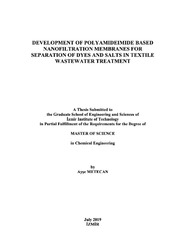Please use this identifier to cite or link to this item:
https://hdl.handle.net/11147/7483| Title: | Development of polyamideimide based nanofiltration membranes for separation of dyes and salts in textile wastewater treatment | Other Titles: | Tekstil atıksuyunun arıtımında boya ve tuzların ayrıştırılması için polamidimid bazlı nanofiltrasyon membranlarının geliştirilmesi | Authors: | Metecan, Ayşe | Advisors: | Alsoy Altınkaya, Sacide | Keywords: | Textile wastewater Nanofiltration membranes Nanofiltration Separation |
Publisher: | Izmir Institute of Technology | Source: | Metecan, A. (2019). Development of polyamideimide based nanofiltration membranes for separation of dyes and salts in textile wastewater treatment. Unpublished master's thesis, İzmir Institute of Technology, İzmir, Turkey | Abstract: | The textile wastewater contains a significant level of organic dyes and inorganic salts. Separation of a vast amount of organic dyes and inorganic salts is important not only to comply with strict regulations but also to recover dyes for reuse during the process. Nanofiltration is proposed as a cost-effective alternative solution for dye and salt separation compared to traditional techniques. The main objective of this thesis is to develop a polyamideimide based positively charged nanofiltration membranes with high permeability, and high selectivity for separation of dyes and salts in textile wastewater treatment. Polyamide-imide (PAI) is an excellent choice for membrane production because of its superior processability, good mechanical features, and high chemical and thermal resistance. Its imide groups are crosslinked with polyethyleneimine (PEI), which is a suitable material to obtain a positively charged surface. In this study, support membranes of various pore sizes were produced by changing the composition of the coagulation bath and casting solution during the phase inversion method. Then, the optimum support membrane was in-situ modified with the alginate and coordinated with the metal ions for high permeability and high selectivity. The influences of the metal concentration and reaction time on the membrane performances were examined. It has been demonstrated that resulted nanofiltration membrane has high solute permeability (>22 L / m2 h bar), high dye rejection (~ 95 %) and low salt rejection (~ 11 %). Moreover, this membrane was tested in the treatment of real textile wastewater samples. Salts in wastewater permeated, while high amounts of dye were rejected. Tekstil atık suları önemli miktarda organik boya ve inorganik tuz içerir. Organik boya ve inorganik tuzun ayrılması, yalnızca yasal düzenlemelere uymak için değil, aynı zamanda işlem sırasında tekrar kullanılmak üzere boyaları geri kazanmak için de önemlidir. Nanofiltrasyon, geleneksel tekniklere kıyasla boya ve tuz ayırma için uygun maliyetli bir alternatif çözüm olarak önerilmiştir. Bu tezin temel amacı, tekstil atıksu arıtımında boya ve tuzların ayrılması için yüksek geçirgenliğe ve yüksek seçiciliğe sahip bir poliamid-imid (PAI) bazlı nanofiltrasyon membranı geliştirmektir. PAI, üstün işlenebilirlik, yüksek mekanik özelliği ile , yüksek kimyasal ve termal direnci nedeniyle membran üretimi için mükemmel bir seçimdir. Imid grupları, pozitif yüklü bir membran elde etmek için uygun bir malzeme olan polietilenimin (PEI) ile çapraz bağ yapabilir. Bu çalışmada, faz inversiyon yöntemi kullanılarak, koagülasyon banyosunun ve döküm çözeltisinin bileşiminin değiştirilmesi suretiyle çeşitli gözenek boyutlarında destek membranları üretilmiştir. Optimize edilen destek membranı aljinat ile modifiye edilmiş, ardından yüksek geçirgenlik ve yüksek seçicilik için metal iyonlarıyla koordine edilmiştir. Metal konsantrasyonunun ve reaksiyon süresinin membran performansına olan etkileri incelenmiştir. Elde edilen nanofiltrasyon membranının yüksek geçirgenliğe (> 22 L /m2 h bar), yüksek boya reddine (~ % 95) ve düşük tuz reddine (~ % 11) sahip olduğu gösterilmiştir. Ayrıca, bu membran, gerçek tekstil atıksu numunelerinin arıtılmasında test edilmiştir. Sonuç olarak, tuzların membrandan geçtiği boya ve renkli bileşiklerin ise önemli oranda membran tarafından tutulduğu belirlenmiştir. Elde edilen membranlar Taramalı Elektron Mikroskobu (SEM), Enerji Dağılımlı X-Ray Analizi (EDX), Zeta Potansiyeli, Atomsal Kuvvet Mikroskopisi ve Temas Açısı ölçümü ile karakterize edilmiştir. |
Description: | Thesis (Master)--Izmir Institute of Technology, Chemical Engineering, Izmir, 2019 Includes bibliographical references (leaves: 55-58) Text in English; Abstract: Turkish and English |
URI: | https://hdl.handle.net/11147/7483 |
| Appears in Collections: | Master Degree / Yüksek Lisans Tezleri |
Files in This Item:
| File | Description | Size | Format | |
|---|---|---|---|---|
| T001903.pdf | MasterThesis | 30.5 MB | Adobe PDF |  View/Open |
CORE Recommender
Page view(s)
62,474
checked on Jul 22, 2024
Download(s)
142
checked on Jul 22, 2024
Google ScholarTM
Check
Items in GCRIS Repository are protected by copyright, with all rights reserved, unless otherwise indicated.